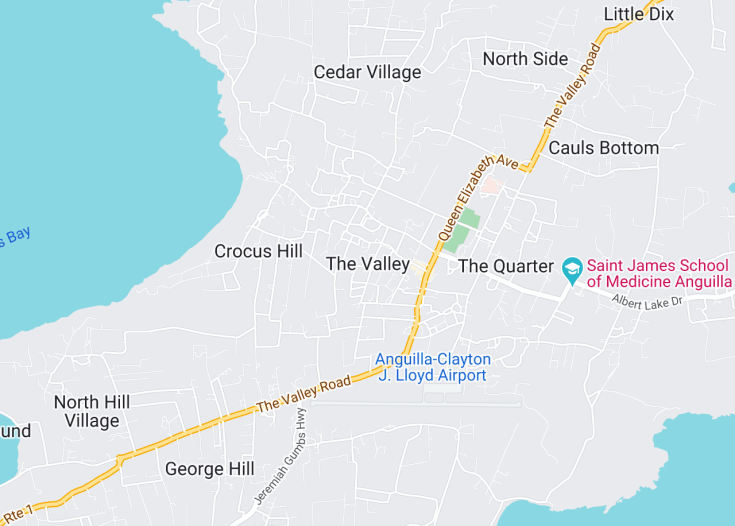The Valley, the charming capital city of Anguilla, offers a unique blend of rich history and modern attractions. Nestled at the heart of the island, it serves as a vibrant hub of culture and commerce. Visitors can explore historical sites like the Wallblake House, discover local arts at numerous galleries, and enjoy the eclectic mix of restaurants and shops. With its serene landscapes and welcoming atmosphere, The Valley is a captivating destination for travelers seeking a mix of relaxation and cultural enrichment.
To make the most of your visit to The Valley, be sure to explore the historic ruins and restored plantations that dot the area – they offer valuable insights into Anguilla’s colonial past.
For seamless travel within The Valley, consider renting a scooter or bike to navigate the city’s picturesque streets and easily access all the attractions.
The Valley: Gateway to Tranquility
| Country | Anguilla |
| Time in The Valley | GMT-4 |
| Language spoken | English |
| Population | 1,067 (2023, World Population Review) |
| Currency | East Caribbean Dollar (XCD) |
| Airports |
|
The Valley, the capital of Anguilla, is not just the administrative hub but also the beating heart of the island’s rich culture and history. Nestled in the middle of Anguilla, this small yet vibrant town offers a mix of colonial history and modern amenities, making it a unique spot for both residents and visitors alike.
Founded during the early colonial period, The Valley features a number of historical buildings that reflect its past, including the Wallblake House. The town’s layout, with its winding streets and old stone buildings, invites exploration and seems to tell stories of the bygone era. Over time, The Valley has grown to be not just a center of political activity but also an essential hub for economic and social gatherings.
Where is The Valley?
Located centrally on the island of Anguilla in the Caribbean, The Valley spans a part of the lush, rolling landscapes that characterize the region.
Distances:
| Route | Distance by car | Time by car |
|---|---|---|
| Blowing Point to The Valley | 6.2 miles | 12 minutes |
| Shoal Bay to The Valley | 4.3 miles | 8 minutes |
| Rendezvous Bay to The Valley | 9.2 miles | 18 minutes |
What is The Valley famous for?
The Valley is famous for its colonial architecture and historical sites such as the Wallblake House, the oldest surviving building on Anguilla. It’s also renowned for its cultural celebrations, including the annual Summer Festival, which showcases the music, dance, and spirit of the island.
History
Pre-Colonial Period (Before 1650)
Before the European colonial powers arrived, the Valley in Anguilla was originally inhabited by indigenous Amerindian peoples, primarily the Arawaks and later the Caribs. These early residents called the island “Malliouhana,” meaning “arrow-shaped sea serpent,” reflective of Anguilla’s unique geographical shape. Their lives centered around fishing, agriculture, and simple village social structures situated near the fertile valleys and abundant waters surrounding the island.
Colonial Period (1650-1967)
Starting from 1650, a series of attempts by the British and French to colonize Anguilla marked the beginning of the Colonial Period. The Valley, as the capital and central district of Anguilla, saw the establishment of plantations primarily fueling a sugar-driven economy, though the island’s infertile soil limited large-scale plantation success. Over the centuries, the British took lasting control, embedding English Common Law, language, and customs into the local culture, significantly shaping the societal structures of The Valley. This era also saw the importation of African slaves, who later became a significant part of the population after emancipation in the early 19th century.
Modern Period (1967-Present)
The Valley witnessed the Anguilla Revolution in 1967 when Anguillans expelled the St. Kitts police force and declared independence from the associated statehood with Saint Kitts and Nevis. Although this self-declared independence was not internationally recognized, it led to direct British Administration until the Anguilla Act of 1980 formally separated Anguilla from Saint Kitts. Today, The Valley is a vibrant hub of government, culture, and tourism, balancing modern growth with its historical legacy.
Visit The Valley
What to see and do in The Valley, Anguilla
The Valley, capital of Anguilla, presents a blend of historical and cultural sites alongside modern Caribbean charm. Key attractions include the Wallblake House, a restored plantation house showing early Anguilla life, and the National Trust Museum offering insights into the island’s natural and cultural history. Exploring the historic ruins and churches, like the Old Valley Church, provides a peek into centuries-old architecture and religious heritage.
- Visit the Heritage Collection Museum to learn about local history.
- Stroll through The Valley streets to discover local art and craft shops.
- Taste local cuisines at traditional Anguillan restaurants.
Festive Traditions in The Valley
The Valley is vibrant with cultural festivities throughout the year. The annual Summer Festival, held in August, features vibrant parades, beauty pageants, boat races, and Calypso music competitions, drawing locals and tourists alike into a colorful celebration of Anguillan culture.
Best time to visit The Valley
The optimal time to visit The Valley is between mid-December and mid-April when the weather is most pleasant, and tourist services are fully operational. This period avoids the heavy rains of the wet season and provides idyllic beach weather, ideal for exploring both the natural and cultural sights.
Is The Valley worth visiting?
The Valley offers a unique insight into the blend of historical richness and serene Caribbean lifestyle, making it a worthwhile destination for those interested in cultural depth and relaxed atmospheres. While it might not boast the commercial entertainment of larger tourist spots, its appeal lies in its uncrowded landscapes and deep-rooted traditions. Potential visitors should be aware of the less frequent public transportation and limited bustling nightlife, which may require planning for transportation and entertainment in advance.









